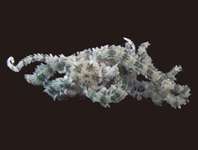Abstract
We describe the first occurrence of the widely occurring brittlestar Ophiactis savignyi (Müller & Troschel, 1842) as epibionts on Caretta caretta (Linnaeus, 1758), the loggerhead sea turtles. On the sea turtle epibionts, the coronulid barnacles were well studied as listed in Hayashi (2013), and recently some crustaceans were collected from loggerhead sea turtles and described as new species (Tanabe et al. 2017; Tanaka and Hayashi 2019). In contrast, echinoderm epibionts listed from sea turtles are poorly understood (Table 1) and this study represents the novel discovery of an ophiuroid, which was not previously known to occur on the surface of this species.
References
Boffi, E. (1972) Ecological aspects of ophiuroids from the phytal of SW Atlantic Ocean warm waters. Marine Biology, 15, 316–328.
https://doi.org/10.1007/BF00401391
Borkhanuddin, M.H., Shaharom, F. & Joseph, J. (2008) Epibionts of hawksbill turtles in Malacca: association with brittle stars (Echinodermata: Ophiolepidae). In: 7th UMT International Symposium on Sustainability and Management (UMTAS) 2008, Primula Beach Resort, Kuala Terengganu, 8–10 June, 2008, pp. 1–10.
Clark, A.H. & Rowe, F.W.E. (1971) Monograph of shallow-water Indo-West Pacific echinoderms. Trustees of the British Museum (Natural History), London, 238 pp.
Clark, H.L. (1919) The distribution of the littoral echinoderms of the West Indies. Publication no. 281. Papers from the Deptnebt oif Marine Biolology Carnegie Institution Washington, 13, 49–74.
Clark, H.L. (1946) The echinoderm fauna of Australia: its composition, and its origins. Publication no. 566. Carnegie Institute of Washington, Washington, 567 pp.
De Felice, R.C. (1999) Fouling marine invertebrates on the floating dry dock USS Machinist in Pearl Harbor prior to its move to Apra Harbor, Guam. In: Bernice, P. (Ed.), Hawai’i Biological Survey Contribution Number 1999-103. Bishop Museum, Honolulu, 15 pp.
Delle Chiaje, S. (1828) Memorie sulla storia e notomia degli animali senza vertebre del regno di Napoli. Vol. 3. Società Tipografica, Napoli, 232 pp.
Frick, M.G., Williams, K.L., Markesteyn, E.J., Pfaller, J.B. & Frick, R.E. (2004) New records and observations of epibionts from loggerhead sea turtles. Southeastern Naturalist, 3 (4), 613–620.
https://doi.org/10.1656/1528-7092(2004)003[0613:NRAOOE]2.0.CO;2
Gondim, A.I., Dias, T.L.P. & Christoffersen, M.L. (2013) Annotated checklist of Echinoderms from Maranhão and Piauí States, Northeastern Brazil. Check List, 9 (3), 510–518.
https://doi.org/10.15560/9.3.510
Hayashi, R. (2013) A checklist of the turtle and whale barnacles (Cirripedia: Thoracica: Coronuloidea). Journal of the Marine Biological Association of the United Kingdom, 93 (1), 143–182.
https://doi.org/10.1017/S0025315412000847
Hayashi, R. (2017) First documentation of the barnacle Fistulobalanus albicostatus (Cirripedia: Balanomorpha) as an epibiont of loggerhead sea turtle Caretta caretta. Marine Biodiversity, 47 (1), 157–158.
https://doi.org/10.1007/s12526-016-0466-5
Hendler, G. & Brugneaux, S.J. (2013) New records of brittle stars from French Guiana: Ophiactis savignyi and the alien species Ophiothela mirabilis (Echinodermata: Ophiuroidea). Marine Biodiversity Records, 6, e113.
https://doi.org/10.1017/S1755267213000845
Linnaeus, C. (1758) Systema Naturae per Regna Tria Naturae. Editio decima reformata, Tomus I. Regnum Animale. Laurentii Salvii, Stockholm, 824 pp.
Monroe, R. & Limpus, C.J. (1979) Barnacles on turtles in Queensland waters with descriptions of three new species. Memoirs of the Queensland Museum, 19, 197–223.
Müller, J. & Troschel, F.H. (1842) System der Asteriden. Friedriech und Sohn, Braunschweig, 134 pp.
O’Hara, T.D., Stöhr, S., Hugall, A.F., Thuy, B. & Martynov, A. (2018) Morphological diagnoses of higher taxa in Ophiuroidea (Echinodermata) in support of a new classification. European Journal of Taxonomy, 416, 1–35.
https://doi.org/10.5852/ejt.2018.416
Omuta, K. (2011) Conservation project on Yakushima Island: the biggest nesting site in Japan. In: Dutton, P.H., Squires, D. & Ahmed, M. (Eds.), Conservation of Pacific sea turtles. University of Hawaii Press, Honolulu, Hawaii, pp. 108–119.
https://doi.org/10.1515/9780824860196-009
Roy, M.S. & Sponer, R. (2002) Evidence of a human-mediated invasion of the tropical western Atlantic by the ‘world's most common brittlestar’. Proceedings of the Royal Society of London B: Biological Sciences, 269 (1495), 1017–1023.
https://doi.org/10.1098/rspb.2002.1977
Schärer, M.T. (2003) A survey of the epibiota of Eretmochelys imbricata (Testudines: Cheloniidae) of Mona Island, Puerto Rico. Revista de Biologia Tropical, 51 (4), 87–90.
Tanabe, Y., Hayashi, R., Tomioka, S. & Kakui, K. (2017) Hexapleomera urashima sp. nov. (Crustacea: Tanaidacea), a tanaidid epibiotic on loggerhead sea turtles at Yakushima Island, Japan. Zootaxa, 4353 (1), 146–160.
https://doi.org/10.11646/zootaxa.4353.1.9
Tanaka, H. & Hayashi, R. (2019) Chelonocytherois omutai gen. et sp. nov. (Crustacea: Ostracoda) from the back of loggerhead sea turtle. Zootaxa, 4624 (4), 507–522.
https://doi.org/10.11646/zootaxa.4624.4.4
Tommasi, L.R. (1970) Os ofiuroides recentes do Brasil e de regioes vizinhas. Contribuicoes Avulsas do Instituto Oceanografico, Universidade de Sao Paulo, 20, 1–146.

